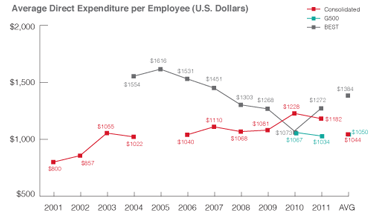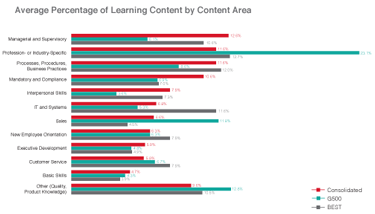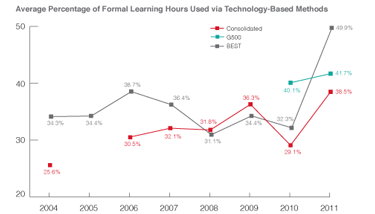
When I led education at PeopleSoft a gazillion years ago, I shared with the head of all customer-facing services a copy of Training Magazine‘s annual numbers issue, published each November (now their November/December issue). His response wasn’t about the numbers, rather, “There’s a magazine just about training?”
Recently I’ve been asked for various stats about workplace learning and the training industry in particular. With the popularity of my stats to make the case for social tools in business post, I realized others may also appreciate information on where to find data about learning at work. Although formal training accounts for only a small percentage of learning, unless noted specifically, the stats here relate to formal training, meaning that managed by a training department, usually through classes or online education (elearning) programs.
I welcome you adding additional sources of training stats in the comments below. I’ll add to this post over time, too.
From Training Magazine’s 2012 Training Industry Report (full download available for free):
After rebounding last year, the training industry hit a bump in the road in 2012 as it followed the downward economic trend that dogged the U.S.: Total 2012 U.S. training expenditures—including payroll and spending on external products and services—fell 6.5 percent to $55.8 billion, according to Training magazine’s 2012 Training Industry Report. Some 65 percent of organizations either saw their training budget remain the same or decrease in 2012. Training payroll increased substantially, from $31.3 billion to $36.4 billion, but spending on outside products and services decreased $1.7 billion to $7.4 billion.
The training budget figure was calculated by projecting the average training budget to a weighted universe of companies, using a Dun & Bradstreet database available through Hoovers of U.S. organizations with more than 100 employees. It is interesting to note that although small companies have the smallest annual budgets, there are so many of them that they account for 62 percent of the total budget for training expenditures.
From the ASTD 2012 State of the Industry (full report available to ASTD members, non-members for a fee):
More than $156 billion was spent by U.S. organizations on [formal] employee learning in 2012.
ASTD estimates that U.S. organizations spent $1,182 per learner on employee learning and development in 2011. Of this total direct learning expenditure, 56 percent ($87.5 billion) was spent internally — such as staff salaries and internal development costs. The remainder was split between tuition reimbursement, which accounted for 14 percent ($21.9 billion), and external services comprising 30 percent ($46.9 billion).

The average direct expenditure per employee decreased in 2011 to $1,182 from a peak expenditure of $1,228 ($1,267 adjusted for inflation) in 2010. This is a 4 percent (7 percent inflation adjusted) decrease on direct expenditure per employee on L&D activities and infrastructure.
Several factors influence the average spending per employee, including company size. Small companies typically spend more per employee on L&D than their larger counterparts. In 2011, small organizations with fewer than 500 employees spent on average $1,605, medium companies with 500 to 9,999 employees spent $1,102, and large organizations with a workforce size of more than 10,000 spent $825 per employee.
Fortune magazine’s Global 500 (G500) organizations that submitted data for the ASTD report on average spent $1,034 per employee on L&D activities and infrastructure in 2011, declining 3 percent from $1,067 in 2010. This group provides insight into spending for large multinational companies, which typically spend less per employee. Despite the slight drop in spending, employees continue to use the L&D opportunities their organizations offer.
On average, employees clocked 31 hours of training in 2011, which is about one hour less than 2010 and six fewer hours than a peak of 37 hours in 2007. However, it is five hours more than employees were using 10 years ago.
The number of learning hours an employee uses at each organization varies as widely as the organizations themselves. Employees at G500 organizations average slightly more than 35 hours of learning, which is almost five hours more than the consolidated average.
Organizations described by ASTD as BEST excel at weaving learning into the corporate culture. For the past seven years their employees have averaged more than 40 hours of learning, and this year employees at BEST organizations used on average 49 hours of learning.
Similar to past years, while the number of hours of learning an employee used remained stable, the cost per learning hour used has increased. The cost per hour of learning has increased by approximately $10 each year for the past four years.
 The top three L&D content areas for the consolidated group in 2011 were managerial and supervisory; profession- or industry-specific; and processes, procedures, and business practices. Together these three content areas account for 36 percent of the learning content available in the reporting organizations. This is not significantly different from last year when the same three categories topped the list and accounted for 34 percent of the learning content available. The bottom three content areas, accounting for 17 percent of the total, are executive development, customer service, and basic skills.
The top three L&D content areas for the consolidated group in 2011 were managerial and supervisory; profession- or industry-specific; and processes, procedures, and business practices. Together these three content areas account for 36 percent of the learning content available in the reporting organizations. This is not significantly different from last year when the same three categories topped the list and accounted for 34 percent of the learning content available. The bottom three content areas, accounting for 17 percent of the total, are executive development, customer service, and basic skills.
Organizations are increasingly implementing the use of technology, and methods such as mobile learning continue to gain in popularity. ASTD defines e-learning as “the use of electronic technologies to deliver information and facilitate the development of skills and knowledge.” After a slight dip in 2010, technology-based methods have rebounded to account for 37.3 percent of formal hours available across all learning methods.
 The consolidated group, BEST organizations, and G500 organizations all reported increased usage of formal learning hours used via technology-based methods. BEST organizations report a record high usage of technology-based learning with 50 percent of their formal learning hours being delivered via a technology-based method.
The consolidated group, BEST organizations, and G500 organizations all reported increased usage of formal learning hours used via technology-based methods. BEST organizations report a record high usage of technology-based learning with 50 percent of their formal learning hours being delivered via a technology-based method.
G500 organizations also have a strong and steady use of technology-based learning, delivering 42 percent of the formal learning hours via technology-based methods. Overall, the consolidated group reports a more moderate use of technology-based methods, accounting for 39 percent of respondents’ formal learning hours.
For the past several years, mobile learning has been a hot topic in the L&D industry. After a slow start, organizations are making progress in offering training via mobile devices. The consolidated group reported 1.4 percent of their training is available on a mobile device compared with 0.4 percent in 2010. With the increasing popularity of mobile devices, this benchmark will be one to closely monitor.
From Bersin by Deloitte’s The Corporate LearningFactbook® 2013: Benchmarks, Trends, and Analysis of the U.S. Training Market report (full report available to member organizations, available to non-members for a fee):
- Mature companies spend 34 percent more. In 2012, U.S. companies spent an average of $706 per learner. However, organizations with mature, effective L&D functions (high-impact learning organizations) spent $867 per learner – 34 percent more than spending by companies at the lowest maturity level. High-impact learning organizations focus on improving performance through training and other talent initiatives. These L&D functions help to build the required human capabilities within their organizations to meet business goals and respond to change.
- Large businesses triple their spending on social learning. Social learning is one catalyst for the transformation in L&D. In 2012, large U.S. companies spent just over $46,000 on average in 2012, nearly triple the spending of just two years ago. Social learning can be extremely effective when incorporated into a more structured program, such as combining a formal course with a learner discussion forum. In addition, high-impact organizations are becoming effective at creating employee networks, connecting novices to experts through expertise directories, and sharing knowledge through communities of practice. In this way, social learning, combined with formal programs, experiential learning and ongoing support and reinforcement, is facilitating a shift from blended training programs to continuous learning environments.
- The L&D footprint continues to shrink. Although many training teams added staff during the year, these additions were outpaced by faster growth in learning populations. As a result, the overall “footprint,” or ratio of training staff relative to the learner population continued to decline in many companies. This trend is one sign of the changing role of the L&D function, which no longer is “the place” for learning. Instead, the role of the L&D team is to facilitate and enable learning. L&D teams should build skills in performance consulting, gain expertise in new technologies including social and mobile, and work to cultivate strong learning cultures within their organizations.
- More spending on products and services. U.S. companies spent on average 16 percent of their training budgets on external learning services, up from 12 percent in 2009. The types of services purchased have changed, with more money going to off-the-shelf content and less to custom instructor-led training, as many companies turn to less costly and more time-efficient learning solutions. The research shows a different trend, however, among high-impact L&D organizations, which spend less on off-the-shelf content and more on instructor-led content development and delivery services. They also invest more in assessment services, which help them to develop skills where needed. Many training organizations start with standardized content, and then recognize the need for a more customized learning approach as they mature.
When asked recently what percent of training was for senior management learning and professional development, here’s how I answered:
“Training Magazine annual report (published last in their November/December 2012 issue) says about 10% of all money in training budgets is for training executives. Large corporations spend on average 11.3M total on training, mid-side orgs 2M, small $295K so theoretically 10% of each of those. Ballparking, that sounds about right to me, although I’ve seen some organizations allocate as much as 20% for senior leaders. Unlike many other parts of the organization that spends their own money on professional development, senior leaders do very little professional development on their own. Two exceptions are those who go get EMBAs (often reimbursed by the employer so that would be included in that 10%). The other exception is conference attendance, which is sometimes combined at a budget level into professional development within the training budget. That happens usually in organizations where funds allocated for T&D are passed down to the department level. In those that don’t, they scrounge for conference dollars wherever they can.”
photo credit: Thomas Hawk, I Can Gather All the News I Need on the Weather Report
